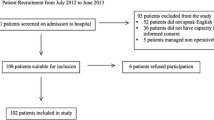Abstract
Background and Purpose:
Risk information is understood differently when it is presented in absolute or relative terms; the latter overemphasizes the magnitude of risk. How surgeons communicate risk may influence patient choice. The aim of this study was to evaluate whether presenting information about the benefits of surgery in absolute and relative terms affects an individual’s decision to accept or reject alternative surgical procedures in hip fracture management.
Patients and Methods:
A face-to-face survey was administered to 50 patients attending the fracture clinic at a university-affiliated hospital. The following baseline information was collected from each patient: (1) age, (2) gender, (3) occupation, (4) highest level of education, (5) ethnicity, (6) type of injury (traumatic, nontraumatic). Patients were asked to consider a scenario (hip fracture) and to decide which treatment alternative they preferred based upon risk presentation. The authors developed this single scenario aimed at identifying how patients’ perceptions about having alternative surgical procedures changed by the manner in which data was presented. The questionnaire was piloted among three surgeons and five patients to ensure clarity. Risk was presented in five ways: (1) absolute risk difference (i. e., 9–6% = 3%), (2) relative risk reduction [(1–6%/9%) × 100 = 33%], (3) relative risk [6%/9% = 0.66], (4) number needed to treat (NNT) [1/0.03 = 33], and (5) odds ratio [AD/BC = 0.67]. After considering each risk presentation, patients expressed their preference for surgery using a 5-point Likert-type scale.
Results:
Patients were 21–88 years old, 66% male, and 66% Caucasian; 60% completed high school; 52% had been treated for previous fractures. Patients were most likely to favor internal fixation when the mortality results comparing internal fixation versus arthroplasty were presented as a relative risk reduction (internal fixation may reduce the risk of mortality by 33% when compared with arthroplasty). Patients continued to favor internal fixation despite being presented with a significantly increased risk of revision surgery—internal fixation definitely increases the risk of revision surgery by > 100% (proportion of patients still favoring internal fixation = 62%, 95% confidence interval 48–80%). Lower level of education and those patients who had not experienced a fracture were significantly associated with their perceptions about method of presentation.
Conclusion:
The findings of this study show how framing risk in relative terms affects the perception of risk and influences patient choice. Patients’ concerns about mortality, even if nonsignificant differences are presented, outweigh concerns about significant increases in revision surgery with internal fixation. Surgeons must use care in utilizing relative risk reductions in the absence of actual risk data given the presented findings that may overestimate the relative benefits of one procedure over another.
Similar content being viewed by others
Author information
Authors and Affiliations
Corresponding author
Additional information
* No funds were received in preparation of this manuscript.
Rights and permissions
About this article
Cite this article
Bhandari, M., Tornetta, P. Communicating the Risks of Surgery to Patients*. Eur J Trauma 30, 177–181 (2004). https://doi.org/10.1007/s00068-004-1370-4
Received:
Accepted:
Issue Date:
DOI: https://doi.org/10.1007/s00068-004-1370-4



